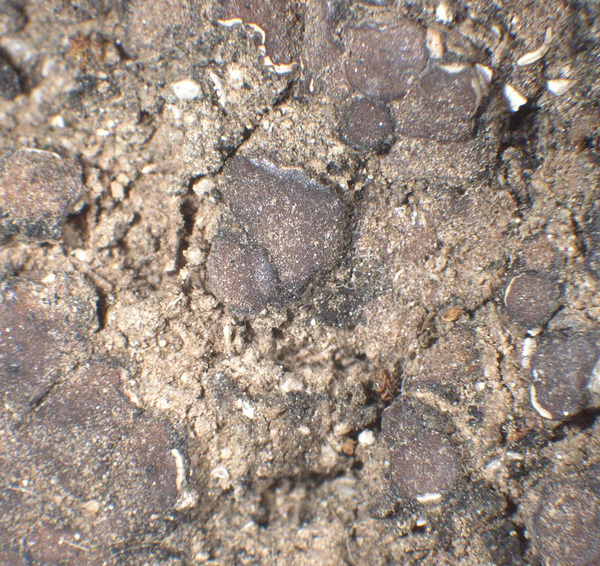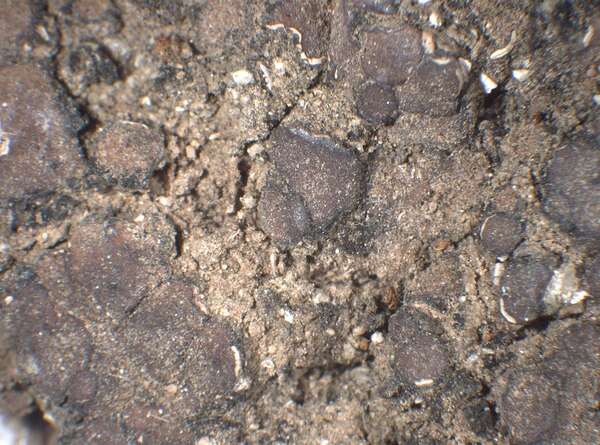Placidiopsis cinerascens (Nyl.) Breuss
Plant Syst. Evol., 148: 315, 1985. Basionym: Endocarpon cinerascens Nyl. - Bot. Not.: 160, 1853.
Synonyms: Catapyrenium circinatum (Bagl.) Jatta; Catapyrenium grappae (Beltr.) Jatta; Catapyrenium pisanum (Bagl.) Jatta; Dermatocarpon baumgartneri (Zahlbr.) Zahlbr.; Dermatocarpon cinerascens (Nyl.) Zahlbr.; Endocarpon grappae (Beltr.) Garov.; Endocarpon pervirescens Nyl.; Placidiopsis baumgartneri Zahlbr.; Placidiopsis circinata Bagl.; Placidiopsis dalmatica Servít; Placidiopsis grappae Beltr.; Placidiopsis pisana Bagl.; Placidium cinerascens (Nyl.) Arnold; Placocarpus cinerascens (Nyl.) Trevis.; Verrucaria cinerascens (Nyl.) Nyl.
Distribution: N - Ven (Breuss 1996b), Piem (Gheza & Nascimbene 2024). C - Tosc (Breuss 1996b), Sar (Breuss 1996b). S - Pugl (Breuss 1996b), Bas (Breuss 1996b, Puntillo 1996, Puntillo & Puntillo 2004, Prieto & al. 2010, Potenza & al. 2010), Si (Nimis & al. 1994, Breuss 1996b, Caniglia & Grillo 2005, 2006, Cataldo & Minissale 2013).
Description: Thallus squamulose, the squamules rounded to lobulate, 1-3 mm broad, 0.15-0.35 mm thick, flattened to weakly convex, smooth, scattered to contiguous, sometimes weakly overlapping at margins, adpressed to the substratum, greenish grey to brownish grey, sometimes pruinose, matt; lower surface pale, attached by 3-4 μm thick, colourless rhizohyphae. Upper cortex 15-25 μm thick, pseudoparenchymatous, covered with a 10-30 μm thick epinecral layer; lower cortex absent or poorly developed. Perithecia frequent, laminal, immersed in the squamules, slightly pyriform to globose, up to 0.3 mm across, without involucrellum. Exciple initially colourless, then brownish, darker only around the ostiole, of tangentially arranged, elongate cells; paraphyses absent, substituted by periphyses, the terminal cells somewhat enlarged; hymenium I+ reddish. Asci 8-spored, narrowly clavate, thin-walled, apically slightly thickened, with a small ocular chamber, K/I-. Ascospores 1-septate, often slightly constricted at septum, hyaline, broadly ellipsoid to subclavate, thin-walled, (13-)15-19(-21) x 5.5-8 μm. Photobiont chlorococcoid (Diplosphaera). Spot tests: cortex and medulla K-, C-, KC-, P-, UV-. Chemistry: without lichen substances. Note: pn clayey, somewhat calciferous but often superficially decalcified soil in grasslands and garrigues below the montane belt; in Italy this species seems to behave as a vicariant of the submediterranean P. cartilaginea in the Mediterranean belt. See also note on P. tenella.
Growth form: Crustose
Substrata: soil, terricolous mosses, and plant debris
Photobiont: green algae other than Trentepohlia
Reproductive strategy: mainly sexual
Commonnes-rarity: (info)
Alpine belt: absent
Subalpine belt: absent
Oromediterranean belt: absent
Montane belt: absent
Submediterranean belt: extremely rare
Padanian area: absent
Humid submediterranean belt: very rare
Humid mediterranean belt: rare
Dry mediterranean belt: rare

Predictive model
Herbarium samples
Growth form: Crustose
Substrata: soil, terricolous mosses, and plant debris
Photobiont: green algae other than Trentepohlia
Reproductive strategy: mainly sexual
Commonnes-rarity: (info)
Alpine belt: absent
Subalpine belt: absent
Oromediterranean belt: absent
Montane belt: absent
Submediterranean belt: extremely rare
Padanian area: absent
Humid submediterranean belt: very rare
Humid mediterranean belt: rare
Dry mediterranean belt: rare

Predictive model
| Herbarium samples |
 Index Fungorum
Index Fungorum
 GBIF
GBIF




